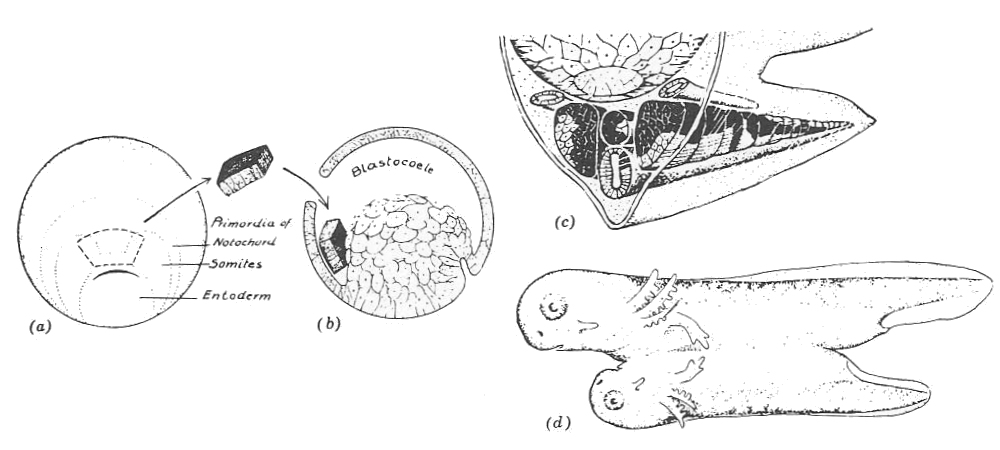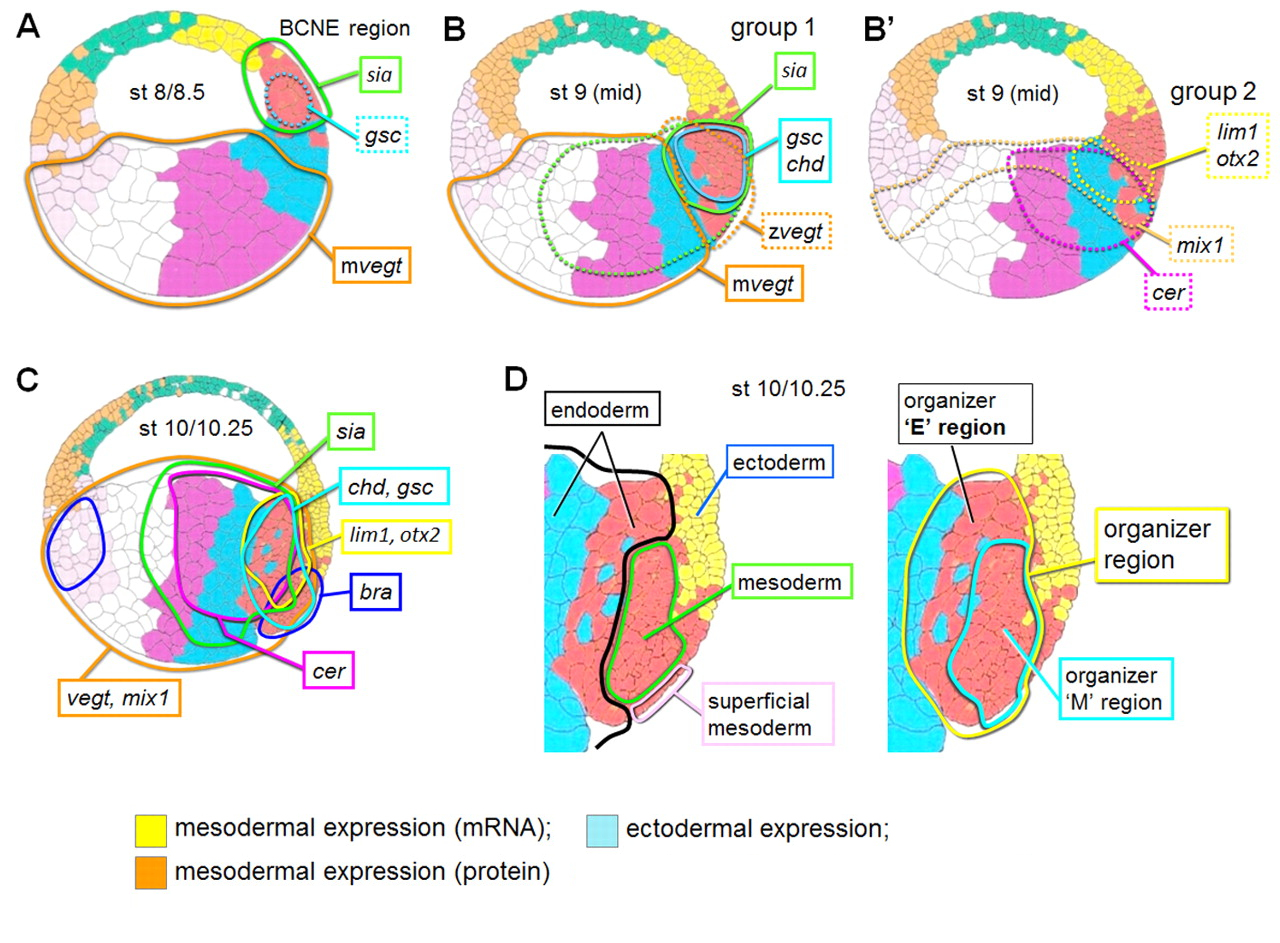
Spemann - Mangold demonstration of the Organizer Principle (1922)
Hilde Mangold (1898 -
1924) was a doctoral student of Hans Spemann. Following
Spemann's demonstration of the importance of the Grey Crescent
in amphibian development, they sought to determine what was
responsible for the critical changes that turned the uniform
cells of the amphibian blastula into the
three-layered ("triploblastic") gastrula.
Differentiation (gastrulation) is initiated by an
inward rolling of cells (epiboly) on the dorsal
surface at a point called the dorsal lip. The embryo
in essence turns itself "inside out": this first
opening is called the blastopore. A second opening
develops later, and is called the deuterostome ("second
mouth", cf. "Deutero + nomy", Second Book of
the Law) which because the anterior end of the digestive
tract and embryo; the blastopore develops as the posterior protostome
("first mouth," based on its prior appearance).
The reorganization of the gastrula with endoderm, mesoderm,
and ectoderm layers is the critical step to
formation of organ systems (see below). It is often argued
that differentiation of the gastrula is the 'true
beginning' of life
To manipulate the system experimentally, Mangold carefully excised the dorsal lip from a donor embryo (a), and exchanged it as a xenograft with another embryo of similar age. These exchanges were done different (but related) species with darker or lighter pigment, so that the origins of tissue types could be followed. The dorsal lip block was placed beneath the epidermal (outermost) layer of the blastula, where it could influence the more superficial layer (b). The exchange itself is a critical control experiment to show that it is not simply transplantation of tissue and (or) the surgical procedure itself that causes the resultant effect. The transplanted dorsal lip invariably induced the formation of a second center of embryonic organization (c), which developed as a neural tube and went on to become a second, "twin" embryo in addition to the primary one already induced in the normal dorsal position (d). The twin had pigment characteristics of the both the donor and the recipient (for examples, see somites).
Spemann called the dorsal lip influence the "First Organizer." The principal that tissues influence the developmental fate of other tissues is now called Induction. Spemann and Mangold were unaware of the nature of the inductive substance.
Mangold performed the experimental manipulations under Spemann's guidance; she died in 1922 in a household accident. The results were not published until 1924, at which point Spemann achieved wide popularity for the novelty of the result, called in some German newspapers "Zwillinge nach Wunche!" ("Twins as you Wish!"). Spemann won the 1933 Nobel Prize: the prize is not awarded to deceased persons (cf. Rosalind Franklin's death prior to the 1962 Nobel for DNA structure). As in other Nobel controversies, the relative contributions of supervisors and students to experiments remains a subject of debate.

To manipulate the system experimentally, Mangold carefully excised the dorsal lip from a donor embryo (a), and exchanged it as a xenograft with another embryo of similar age. These exchanges were done different (but related) species with darker or lighter pigment, so that the origins of tissue types could be followed. The dorsal lip block was placed beneath the epidermal (outermost) layer of the blastula, where it could influence the more superficial layer (b). The exchange itself is a critical control experiment to show that it is not simply transplantation of tissue and (or) the surgical procedure itself that causes the resultant effect. The transplanted dorsal lip invariably induced the formation of a second center of embryonic organization (c), which developed as a neural tube and went on to become a second, "twin" embryo in addition to the primary one already induced in the normal dorsal position (d). The twin had pigment characteristics of the both the donor and the recipient (for examples, see somites).
Spemann called the dorsal lip influence the "First Organizer." The principal that tissues influence the developmental fate of other tissues is now called Induction. Spemann and Mangold were unaware of the nature of the inductive substance.
Recurrent questions
Mangold performed the experimental manipulations under Spemann's guidance; she died in 1922 in a household accident. The results were not published until 1924, at which point Spemann achieved wide popularity for the novelty of the result, called in some German newspapers "Zwillinge nach Wunche!" ("Twins as you Wish!"). Spemann won the 1933 Nobel Prize: the prize is not awarded to deceased persons (cf. Rosalind Franklin's death prior to the 1962 Nobel for DNA structure). As in other Nobel controversies, the relative contributions of supervisors and students to experiments remains a subject of debate.
Modern fate map of the
gastrular tissues movements.

Text material © 2022 by Steven M. Carr